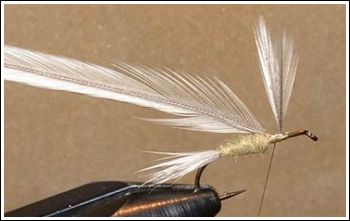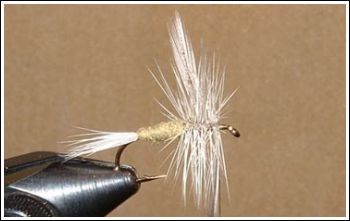|
Tying the Blue Wing
Olive (BWO)
By Jason Akl

Blue Wing Olive (BWO) Dry
Fly
Found
on streams throughout the United States, the blue winged olive (BWO)
mayfly is a staple food source on which trout rely year round. If the
weather is cold, clammy and wet, chances are good that trout will be
actively feeding on blue wing olive duns. During these types of overcast
conditions trout will feed during the warmest part of the day, giving
anglers a good chance at presenting dries to rising fish.
Blue wing olives mainly hatch
throughout cooler temperature ranges and well into the winter, making
these fly patterns a must for any serious fly angler. Adult flies look
like little tiny sailboats drifting softly on the water's surface. These
duns often have olive bodies and wings that vary from light gray to
black.
These mayflies are known to
hatch in slow to medium riffle runs that lead into slower water. Fly
anglers should be conscious of this hatching behavior and key on spots
where the current funnels floating insects from a fast run to a deep
pool where fish can lay in stealth.
Since BWO size varies throughout
the year, it is a good idea for fly anglers to carry dries that range
from size 16 all the way down to a tiny size 24. At first glance, dries
this small seem to be almost inconsequential to a large trout's diet,
but don't be mistaken. A size 24 may be hard for anglers to see on the
water's surface, but selective trout easily find them. Fly anglers
fishing the wrong size BWO during a hatch often watch in frustration as
feeding fish ignore their fly drift after drift.
Use traditional dry fly tackle
to fish BWOs. Nine-foot fly rods (stream environment permitting) and
floating lines should be all you need. Standard nine- to twelve-foot
leaders tapered to either 4X or 5X are ideal for presenting dries softly
to fish. Fishing tiny dry flies does not have to be a daunting task. A
trick for fly anglers is to use a dropper leader system which puts a
larger dry (size 16 or 18) about a two to three feet above the smaller
dry. This system allows the angler to spot the larger fly and follow it
down to the tiny size 24 fly more easily. BWO's might not be the biggest
hatch you will come across, but fishing these dry flies before the sun
warms things up will likely get fish rising.
Blue Wing Olive Materials List
Hook: Dry Fly Hook Size 18
Thread: Olive Uni-Thread Size 8/0
Hackle: Blue Dun Dry-Fly Hackle (Size 18)
Tail: Blue Dun Dry-Fly Hackle Fibers
Body: Olive Super Fine Dubbing
Wings: Blue Dun Dry-Fly Hackle Tips
Step-By-Step Tying Instructions
Step 1. Place your hook in the
vice and secure tightly in place.

Step 2. Attach the thread to the
hook shank at the 3/4 mark on the shank.

Step 3. Select and align the
tips of 12-15 blue dun dry-fly hackle fibers. Tie these fibers onto the
hook shank at the point above the barb. They should be about
one-and-a-half times the length of the hook gap.

Step 4. Select and align two
blue dun dry-fly hackle tips so that they flare away from one another
when held back to back. The wings, when finished, should be
approximately the length of the hook shank.

Step 5. Strip all the hackle
barbs off of the feathers leaving just the tips. Tie these tips down to
the hook extending over the hook eye at the 3/4 mark on the shank.

Step 6. Stand the wings upright
and place several thread wraps in front of the base to keep them in
place.

Step 7. Advance the thread back
to the rear end of the shank and pinch dub your thread very lightly with
the super fine dubbing. Build a small tapered body up the hook shank,
stopping just behind the wings.

Step 8. Strip the bottom section
from a blue dun dry-fly hackle, leaving the stalk exposed, and tie this
just behind the wings.

Step 9. Advance the blue dun
dry-fly hackle up the body of the fly, taking four to five turns of
hackle behind the wings and three turns in front of the wings.

Step 10. Build a small neat head
for the fly, whip finish the thread and cement.

Text and photos by
Jason Akl
© |